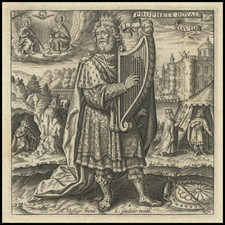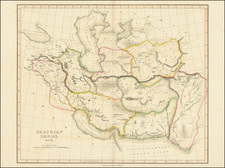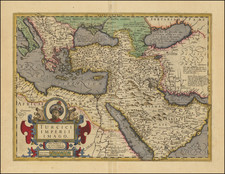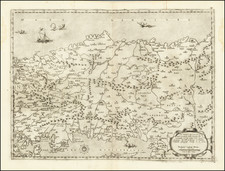A Biblical Map of the Ancient World (after the Flood) by A Remarkable World Traveller
Rare educational wall map of "the Ancient World", published by Antonia Frederick Fuller, who is often thought to be the inspiration for Indiana Jones.
Antonia Frederick Futterer's map of the Ancient World after Noah represents a convergence of biblical narrative and cartographic interpretation. Published in Los Angeles in 1911 by Antonia Frederick Futterer, this document provides an illustrative account of the repeopling of earth following the flood, as part of "Futterer's Bible Eyeography" in an attempt to master the Bible by sight.
This map meticulously plots the territories attributed to the sons of Noah—Shem, Ham, and Japheth—across the known continents of antiquity: Asia, Africa, and Europe. Created as part of an educational series designed for rapid historical instruction, this early 20th-century artifact merges theological genealogy with geographic demarcation.
Japheth's lineage, traditionally associated with the expansion into Europe and parts of Asia, encompasses figures such as Gomer and Magog, reputed founders of ancient tribes in those regions. Their territories are indicated near the Black Sea and in the lands that would correspond to modern-day Turkey, with Tubal and Meshech situated in proximity, highlighting a biblical interpretation of the settlement patterns that would come to define these areas.
The map traces Ham's descendants to Africa and parts of the Near East. Mizraim, identified with ancient Egypt, and Phut, associated with regions in North Africa, are prominently displayed. Notably, the Canaanites, ascribed to Ham's progeny, are depicted in the Levantine corridor, a region of significant biblical import.
Shem’s lineage, with notables such as Elam, Asshur, and Arphaxad, is illustrated as having settled in the Fertile Crescent, an area encompassing parts of today's Middle East. The map marks important biblical sites and peoples, such as Aram and Lud, placing them in the context of the broader Mesopotamian cradle of civilization, with its rich and complex history.
Central to the map’s narrative is the chronology of the Antediluvian patriarchs, denoting significant figures like Adam, Noah, Shem, and Arphaxad, with their respective lifespans. This chronological detailing provides an additional layer of interpretive history, situating the genealogical mappings within a specific temporal framework.
At the far right is an interesting depiction of Alaska, the Behring Straits, China, Japan and Siam, offering a curious ethnographic suggestion regarding the proximity of Asian and American Indian/Eskimo and hinting at their relationship as part of the anti-diluvian diaspora.
The map was apparently part of a series, Futterer's New Map System of Rapid Education. Futterer's subtitle, "Mastering the Bible By Sight," illustrates the intent to provide a visual supplement to the scriptural text. The publication history, in both London and subsequently in Los Angeles signifies the widespread interest in biblical scholarship during the period, and the map's design reflects the pedagogical methods of the time, focused on memorization and visualization.
The cartographic style of the map reflects the early 20th-century didactic approach to biblical education. This piece stands as a remarkable example of the era's educational prints, offering a richly detailed and thought-provoking representation of a world long contemplated in theology and literature.
Futterer seems to have had a long history in bible education. We note a title copyrighted dated March 4, 1909, and renewed September 26, 1939, entitled "World. 4,000 years of history in one hour, by Futterer's new map system of Rapid Education." The Newberry Library and University of Chicago hold copies of the 4th edition of this work, published in 1918 in New York by the "New Eye-ographic System Bible Promoters' Club," entitled:
Fütterer's patent universal eye-ographic Bible atlas: (4000 years' history visualized in one hour) for Bible students, Sunday schools and Bible colleges, in three editions--Protestant, Catholic and Jewish.
The Bible atlas was described as:
The lastest rapid simple self-instructing map-chart system. A three-fold instructor 1 --- seeing, 2 --- traveling, 3 --- hearing."/ "Bible students' improved handy loose-leaf edition 1918. Can be taken apart and extra loose leaves inserted."/ At foot of maps: This map can be used with all Sunday school lessons or lectures. It is published for wall use 52 x 36 inches / Publisher's advertisements on p. 31.
A similar work is recorded in OCLC, published in 1912, entitled 4000 years history in one hour, which apparently consisted of 10 sheets (21 x 28 inches each), is held in the Eran Laor collection at Jerusalem National Library.
This map was acquired as part of a set of 4 maps, numbered lessons 1, 2, 3 and 5, suggesting that at least 1 map in the set may have been missing. However, as the wall maps essentially unrecorded, we can only surmise that these are 8 of the 10 sheets reference in the note above in the Jerusalem National Library.
- Lesson 1: New Map of Antediluvian Period
- Lesson 2: New Map of the Ancient World
- Lesson 3: New Map of Life & Travels of Abraham Gen. 11 to 25
- Lesson 5: New Map of Egyptian Slavery and Wilderness Journey Exodus & Numbers
We were not able to connect this work to a London publication.
Rarity
The map is extremely rare. We were unable to locate any other surviving examples.
Antonia Frederick Futterer, an illustrious figure in the realm of biblical scholarship and preaching, was born inf Sydney, Australia on June 12, 1871, to a German father and Danish mother. Futterer’s early years were spent in Australia where, during the 1890s, the lure of gold brought him to Coolgardie, Western Australia. However, serious health issues, namely recurrent appendicitis, cut his endeavors short and almost claimed his life.
During a period of convalescence, Futterer read a passage from the Book of Proverbs in the Bible. This encounter with scripture led to a personal vow to dedicate his life to preaching if he were to recover, a promise he fulfilled upon his return to health. He took this commitment back to the mining camps, where he began his work as a preacher.
Futterer’s journey took a significant turn when he was sent to America by preacher Alexis Jeffries. By 1911, Futterer had developed the “Eye-Ographic Bible Atlas” in Oakland, California. This work was an innovative educational tool, combining illustrations and concise narratives to aid in teaching the Old Testament.
His quest for biblical knowledge and artifacts led to his founding of the Bible Knowledge Society in Los Angeles in 1924. Futterer's fascination with biblical history propelled him to the Holy Land in pursuit of the Ark of the Covenant, an endeavor that, despite not yielding the intended discovery, resulted in the acquisition of many historical artifacts, and contributed to the story that Futterer was the real life inspiration for the Indiana Jones character.
These artifacts became the cornerstone of the Holyland Exhibition in California, which Futterer established to showcase the cultural and historical treasures he had collected. This exhibition remains a reservoir of ancient relics from various biblical lands, including oil lamps, jewelry, and a sarcophagus dating back thousands of years.
In the latter part of his life, Futterer authored one of the first modern travel guides to the Holy Land, titled “Palestine Speaks,” and contributed to film productions with his collection of artifacts.
Futterer's life, though shrouded in some mythological layers akin to those of the fictional Indiana Jones, was grounded in the earnest endeavor to educate and illuminate the historical context of the Bible. His legacy, preserved in his writings and the Holyland Exhibition, continues to offer a glimpse into the rich tapestry of biblical history.
Futterer's legacy is interwoven with the fabric of Southern California's spiritual history, standing shoulder to shoulder with contemporaries such as Aimee Semple MacPherson. His life and endeavors have led some to draw parallels with the fictional character Indiana Jones, the iconic archaeologist and adventurer of film fame. While Futterer never discovered the Ark of the Covenant, his extensive travels to the Holy Land, the artifacts he gathered, and the public nature of his quests contributed to this speculation. Like Indiana Jones, Futterer was a charismatic figure who embarked on intrepid expeditions, engaging with historical mysteries and ancient texts. He sought out biblical relics with a passion that matched the cinematic hero's quest for lost treasures.











![[ Biblical Names for Palestine ]. Carte de La Palestine Ancienne et Moderne avec le Sud du Liban et de l'Anti-Liban et les régions situées à l'est du Jourdain et de la Mer Morte, pour servir à l'étude de la Bible par A. Legendre [Map of Ancient and Modern Palestine with Southern Lebanon and Anti-Lebanon and the regions east of the Jordan and the Dead Sea, for use in the study of the Bible by A. Legendre]](https://storage.googleapis.com/raremaps/img/small/85737.jpg)
![[Holy Land] Terra Sancta XXIII. Nova Tabula](https://storage.googleapis.com/raremaps/img/small/100585.jpg)



